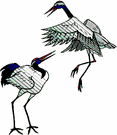Things were quieting down as it was getting late this morning as I was finishing some Breeding Bird Atlas surveying. Then, an adult Cooper's Hawk flew in and it was as if the area exploded--a pack (they acted like a pack of watchdogs) of Western Kingbirds (parents and their fledglings) flew after the Cooper's screeching as loudly as they could (and with 5 or 6 of them, it was very loud). And the Cooper's vociferously protested as the Kingbirds appeared to make contact with it. The Cooper's flew into a tree with a Bullock's Oriole nest and right at the nest. It appeared to be trying to get a bird out of the nest and indeed looked like it had something in it's talons as it flew off, the kingbirds (the Western Kingbirds were now joined by several Cassin's Kingbirds that flew in from to assist) chasing along.
Conspicuously missing in this foray were any Bullock's Orioles. I thought maybe their offspring had fledged and they had left. Not so.
This evening I returned to this location to do some birding (I have been watching a Red-tailed Hawk with two nestilings whose nest is on a small ledge on some cliffs there and some other cliff dwellers) and again an adult Cooper's Hawk burst out of a large juniper and flew right to the Bullock's Oriole nest. Repeating this morning's battle, the Western Kingbirds were on it. Though the Cooper's again tried to get a bird from the nest it did not appear successful this time and flew off with the kingbirds in tow.
After things quieted down, a female Bullock's Oriole flew up from some nearby shrubs calling excitedly (in belated concern?). Another oriole called excitedly from across the road but never flew up. The female oriole flew up to near the nest but just kept calling and did not go in or even look in. I moved away thinking she might not want to go to it with me nearby. When she still didn't go in I drove aways off but she just finally flew back into the shrubs.
So, had the Bullock's Oriole offspring already fledged? That would seem unlikely since the Cooper's would not likely made a second try this evening if there weren't any birds in the nest. Oh, if only the kingbirds could talk. Would they say, "darn those irresponsible orioles, they don't take care of their kids and we have to do it."
We will never know the answers but I sure learned that those kingbirds are as good as any watchdog. Whether they had some inkling that the Cooper's was around or not, I would love to have those kingbirds in my neighborhood watch group.
Also in the same area today I watched a pair of Red-tailed Hawks (likely the parents from the cliff nest that is not far away) harass a sub-adult Golden Eagle that has a roost in the bird's neighborhood. I was surprised how agile the eagle was as it twisted upside down as it made flight maneuvers to avoid the almost kamakazi attacks by the hawks.
In between these aerial dramas I got to watch a pair of Brown-headed Cowbirds copulate, a Violet-Green Swallow fly in and out of a nest hole (literally a hole, about 6-10 inches in diameter, in the rock face) on the cliffs and a White-throated Swift grooming itself while perched on a ledge (unusual for this species, possibly has a nest in back of the ledge) on the cliffs.
This is why I love birding. (sorry, no pics as the action with the Cooper's was so fast it was hard enough to follow it visually, and the other birds were too distant on the cliffs)
SeEtta
Labels: Cooper'sHawk, kingbirds


















































